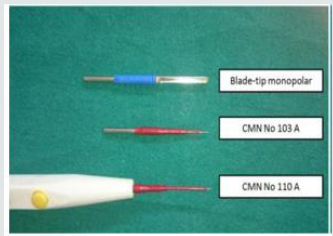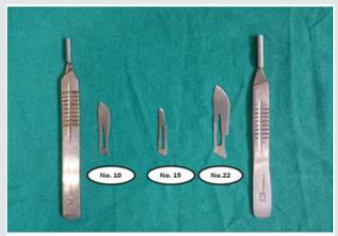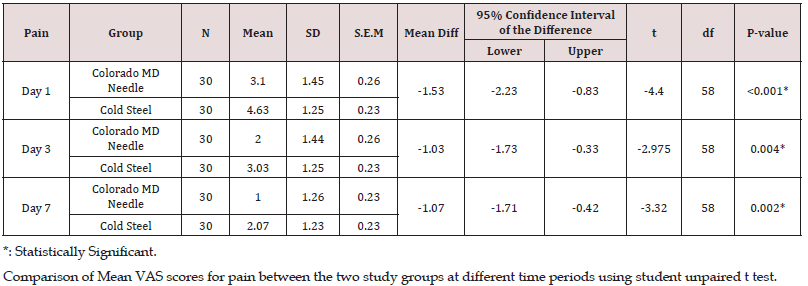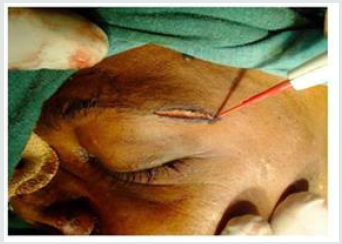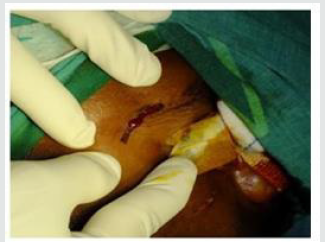
Lupine Publishers Group
Lupine Publishers
Menu
ISSN: 2641-1709
Research Article(ISSN: 2641-1709) 
A Comparative Study of Colorado Micro Dissection Needle Versus Scalpel in Maxillofacial Surgery Volume 6 - Issue 1
Milan Modi1, Sham ME2, Suresh Menon3, Veerendra Kumar4, Archana S4 and Dhanush CV5*
- 1Department of Faciomaxillary Surgery, India
- 2Professor, Department of Faciomaxillary & Microvascular Reconstruction Services, Vydehi Institute of Medical & Dental Sciences, India
- 3Head & Professor, Department of Faciomaxillary Surgery, Vydehi Institute of Medical & Dental Sciences, India
- 4Associate Professor, Department of Faciomaxillary Surgery, Vydehi Institute of Medical & Dental Sciences, India
- 5Senior Surgical Resident, Department of Faciomaxillary Surgery, Vydehi Institute of Medical & Dental Sciences, India
Received: February 18, 2021; Published: March 02, 2021
Corresponding author:Dhanush CV, Senior Surgical Resident, Department of Faciomaxillary Surgery, Vydehi Institute of Medical & Dental Sciences, India
DOI: 10.32474/SJO.2021.06.000229
Abstract
Purpose: Current advances in equipment technology have offered us with tremendous advantage in performing various surgeries. Among these is the Colorado electro micro-dissection needle. Although use of electro surgery dates back to 1909 when it was first used to fulgratetumors, to 1926 when “Cushing” first introduced it in neurosurgery. Its use to open skin has been rejected or reserved in past for fear of delayed wound healing or infection. Currently there is enough literature and evidence to support favorable use of electro-cautery as a complete or partial substitution to cold steel, in terms of operative blood loss, post-operative pain and surgical scar.
Materials and Method: This study clinically evaluated the safety and efficacy of Colorado micro dissection needle over cold steel in skin incisions in 60 patients undergoing various maxillofacial procedures. The study was done to compare the efficacy of Colorado micro-dissection needle and cold steel (Scalpel) in oral and maxillofacial surgeries; for post-operative scar (3rd/6th months), incisional blood loss, post-operative pain and total time taken to complete the length of incision.
Result: The study sample contained 60 patients with ages ranging from 18-60years. Thirty patients were included for Colorado micro dissection needle group (group I) and 30 for cold steel (Scalpel) group (group II).The average time taken for incision with the Colorado micro dissection needle was 18.40seconds, as compared to the cold Steel which was 39.63 seconds. The time taken for incision with Colorado micro dissection needle was less than Cold Steel. Post-operative pain was less when using Colorado micro dissection needle. In the Colorado micro dissection needle group, mean width of the scar was 1.68 mm per incision at 3rd month interval and 1.20 mm at 6th month interval per incision. In the Cold Steel group, mean width of the scar was 2.48 mm per incision at 3rd month interval and 2.23 mm per incision at 6th month interval. It was noted that, a Colorado micro dissection needle gives less width and better scar than Cold steel.
Conclusion: The findings of this study recommend the use of the Colorado micro dissection needle in all maxillofacial procedures.
Keywords: Colorado micro dissection needle; cold steel (scalpel); skin incision; oral and maxillofacial surgery
Introduction
Elective surgery requires planned incisions, and these require appropriate blades. Major elective incisions are used for sectioning of skin, vessels, deeper tissue and most commonly the internal organs. If particular blades have evolved specific to each tissue incised, their remote origins remain mundane. In all probability ‘surgical’ blades were borrowed from domestic items and weaponry, at least until some 2000 years ago; in certain primitive societies such sources persist today [1]. Incisions on skin with a cold steel (scalpel) have been associated with unfavorable side effects such as excessive blood flow with inadequate visibility caused by blood in the operating field [2]. Current advances in equipment technology have offered us with tremendous advantage in performing various surgeries. Among these is the Colorado electro micro-dissection needle. Although use of electro surgery dates back to 1909 when it was first used to fulgurate tumors, to 1926 when “Cushing” first introduced it in Neurosurgery [3]. The general surgical use of electrocautery had been mainly reserved for incising and dissecting the subcutaneous tissue and deeper layers. The use of the electrocautery scalpel to open skin has been rejected or reserved in past for fear of delayed wound healing or infection [4]. Currently there is enough literature and evidence to support favorable use of electro-cautery as a complete or partial substitution to cold steel, in terms of operative blood loss, post-operative pain and surgical scar [4-6]. The electrocautery knife has been used widely by general surgeons to create abdominal and thoracic incisions, with excellent results. The need for a fast and more hemostatic method to create incisions is even more important in Neurosurgery, particularly for scalp incisions and in the paediatric age group. The concept of electrocautery incisions is fast gaining acceptance not only amongst the neurosurgeons, but also the orthopedics, the general surgeons for thoracic and abdominal incisions and the myths behind its complications are soon fading with excellent result.
Materials and Method
The present study of comparing Colorado micro dissection needle &scalpel is a prospective randomised controlled study conducted in Department of Maxillofacial Surgery for 2 years. Sixty prospective male/female patients requiring maxillofacial surgery under general anesthesia were included in our study.
Inclusion criteria
\a) Patients between 18-60 years of age undergoing maxillofacial procedure.
b) Patients within ASA I and ASA II group.
c) Extra-oral incisions in maxillofacial region.
Exclusion Criteria
a. Previous history of keloids or hypertrophic scars
b. Intraoral mucosal incision.
c. Armamentarium
d. Colorado Micro Dissection Needle N 103 A and N 110 A (Figure 1).
e. Cold Steel (Scalpel) & Blade (Sizes No.10, No. 15, and No. 22) (Figure 2).
f. Generator unit
g. Gauze and Digital weighing machine
Colorado micro dissection needle
The needle used was N110 A (2.3622 mm sleeve diameter). Generator unit was set at between 10W to 15W for both cutting and coagulation & 390 kHz sinusoid waveform. N 103 A and N 110 A Colorado micro dissection needle were used alternatively. The incision depth included dermis, epidermis, and fascia. No local anesthesia with vasoconstrictor was used in this series.
Cold steel (Scalpel)
Depending on type of incision and area of incision; blade sizes 10, 15 and 22 were used. Incisions were made through dermis, epidermis, and fascia. Local anesthesia 2 % Lidocaine with 1: 2,00,000 adrenaline was used in this series. Amount of blood loss in both groups was recorded or measured by the gross weight of soaked gauze at the end of each incision. On post-operative days 1, 3 and 7; intensity of pain was recorded using visual analog pain scale. Total time taken for the incision = length of the incision divided by time in seconds. The width of postoperative linear scar was evaluated in millimeters at the end of 3rd month and 6th month interval, respectively.
Results
The study sample contained 60 patients with ages ranging from 18-60 years. Thirty patients were included for Colorado micro dissection needle group (group I) and 30 for cold steel (Scalpel) group (group II). The mean age of patients in the Colorado micro dissection needle group was 32.1 years with 23 males and 7 females. The mean age of patients in the Cold Steel group was 32.6 years with 25 males and 5 females. The incisions included in Colorado micro dissection needle group (group I) were subciliary-1 (3.30%), subtarsal-2 (6.70%), lateral eyebrow-6 (20%), hemicoronal-1 (3.30%), Thoma’s-2 (6.70%), Al-kayat & Bramley-7 (23.40%), retromandibular-3(10%), submandibular-5(16.70%), submental-1 (3.30%), rhytidectomy-1 (3.30%) and Weber-Ferguson-1 (3.30%). The incisions included in cold steel (Group II) were subciliary-1 (3.30%), subtarsal-1 (3.30%), infraorbital-1 (3.30%), lateral eyebrow-7 (23.30%), hemicoronal-2 (6.70%), Thoma’s-1 (3.30), Al-kayat & Bramley-6 (20%), retromandibular-4 (13.50%), submandibular-5 (16.70%), submental-1(3.30%) and Weber- Ferguson-1 (3.30%).
Pain parameters between Group I and Group II (Table 1)
Postoperative pain was assessed in the recovery room, on 1st , 3rd, and 7th post-operative days. The results and statistical analysis are tabulated below. It was evaluated by using a visual analogue scale ranging from 0 to 10, 0 being no pain and 10 being worst possible pain. In the Group I, pain score on 1st post-operative day ranged from 1 to 7 (mean 3.10), pain on 3rd post-operative day ranged from 0 to 6 (mean 2), pain on 7th post-operative day ranged from 0 to 5 (mean 1). In the Group II, pain score on 1st post-operative day ranged from 1 to 7 (mean 4.63), pain on 3rd post-operative day ranged from 0 to 6 (mean 3.03), pain on 7th post-operative day ranged from 0 to 5 (mean 2.07). The results showed that there was statistically significant difference in pain intensity between Group I and Group II.
Incisional bleeding of Group I and Group II (Table 2)
Amount of blood loss in both groups was recorded or measured by the gross weight of soaked gauze at the end of each incision. In the Colorado micro dissection needle group (Figure 3) mean blood loss was 1.21 ml per incision and in the cold steel group (Figure 4) mean blood loss was 5.31 ml per incision. The results showed that there was statistically significant difference in blood loss between Colorado micro dissection needle and cold steel.
Incision time (seconds) of Group I versus Group II (Table 3)
The speed of skin incision was calculated in mm/s from the start of incision till completion of the incision, including hemostasis. The average speed of incision with the Colorado micro dissection needle was 18.40 seconds, as compared to the cold steel which was 39.63 seconds. The mean difference column which depicts the P-value as a result of a paired t-test has shown little significance.
Width of the scars of Group I versus Group II (Table 4)
The width of scar was evaluated in mm at 3rd and 6th month postoperative period. In the Colorado micro dissection needle group mean width of the scar was 1.68 mm per incision at 3rd month interval (Figure 5) and 1.20 mm at 6th month (Figure 6) interval per incision. In the cold steel group, mean width of the scar was2.48 mm per incision at 3rd month interval and 2.23 mm per incision at 6th month interval. It was noted that, a Colorado micro dissection needle gives less width and better scar than cold steel (Scalpel) and there was statistically significant difference in width of the scar in Colorado micro dissection needle versus cold steel.
Discussion
The Colorado micro dissection needle (Stryker-Leibinger, Freiburg, Germany) was introduced into clinical practice with various applications [5]. The instrument tip is a delicately machined, insulated tungsten diathermy needle that is compatible with any standard cautery hand piece. The advantage of this micro dissection needle has been described by Farnworth and colleagues (1993) [6]. They microscopically examined and compared incisions made with standard electrosurgery, the micro dissection needle and the Shaw hemostatic scalpel. The study showed that by decreasing the surface area of the electrosurgery device, higher power densities are sustained at comparatively low wattage. The net result permits reduced dissipation of heat energy into the surrounding tissue. This results in a smaller zone of tissue necrosis than conventional cautery devices [6]. One of the reported benefits of electrosurgery is the significant reduction in cutting time [5,7- 9]. The study reported by Kearns et al, mean differences in cutting time 40 seconds favor of electrosurgical incisions [8]. Sheikh B reported, the speed of incision when the steel scalpel was used ranged between 0.17 and 0.37 mm/s, with an average of 0.3 mm/s. The speed of incision when the Colorado micro dissection needle electrocautery scalpel was used ranged between 1.8 and 2.5 mm/s, with an average of 2.3 mm/s [7]. According to the study reported by Madhukar KT et al., the speed of incision when a cold scalpel was used ranged between 0.15 mm/s and 0.4 mm/s, with an average of 0.2 mm/s. The speed of incision with electrocautery blade was between 1.3 mm/s and2.8mm/s, with an average of 1.8 mm/s [9]. Our study showed a mean difference between Colorado micro dissection needle and the cold scalpel, the time taken for incision with Colorado micro dissection needle was less than cold steel, however, it was not statistically significant [10].
Incisional blood loss with Colorado needle is reportedly significantly less when compared to the steel scalpel incisions [5,7,8,11]. Sheikh B reported approximately four times more blood loss with a steel scalpel when compared to the Colorado micro dissection needle for scalp incisions in neurosurgical procedures [7]. Rideout B et al. compared results with those of a number of recent reports in the literature that described other advocated tonsillectomy techniques and authors found Blood loss was least for Electro micro dissection tip than cold steel [5]. N Nitta et al. reported that, the blood loss was three to five time lesser using the micro needle electrocautery scalpel compared to cold steel (scalpel) for scalp incisions in neurosurgical procedures [11]. The study reported by Kearns et al, incisional blood loss with electrosurgical incisions is reportedly significantly less when compared to the steel scalpel incisions.8The present study showed that almost all cases had less incisional blood loss with Colorado micro dissection needle, supported by a statistically significant result. The postoperative pain is probably of utmost importance to the patient [5,12]. Rideout B et al. compared results with those of a number of recent reports in the literature that described other advocated tonsillectomy techniques and author found post-operative pain was much lesser for Electro micro dissection tip than cold steel [5]. Perkins J determined micro dissection needle for tonsillectomy resulted decreased postoperative pain when compared with standard electro-cautery [12]. In our study, as expected, the mean pain scores for both modalities decreased at each pain assessment after surgery. The mean pain scores for Colorado micro dissection needle were less and P- value suggest statistically significant.
One of the concerns regarding electrosurgery was the theoretical risk of increased wound complications due to the heat production which results in a zone of tissue necrosis adjacent to the incision [13]. It was proven by several studies that electrosurgically created incisions showed less increased incidence of wound complications such as dehiscence and infection. This was shown by Sheikh B, Sharma R and N. Nitta et al. No data investigating the wound complications for craniofacial incisions with the Colorado micro dissection needle could be found [4,7,11]. There are no reports which suggest that the wound infection rates have increased by use of the electrocauteries (Colorado micro dissection needle) in neurosurgical cases [7]. According to this study, at 6 months followup the level of the scar as compared with surrounding skin, colour match, consistency and width were normal in all the cases [4]. N Nitta et al. suggest use of Colorado micro dissection needle, results in minimal wound damage, minimal scarring, excellent healing and minimal alopecia as it works with minimal electric contact technique [11]. In the present study, 60 incision were considered in which two of the incisions showed infection and dehiscence belonging one from each group. This is well within the acceptable range of maxillofacial wound infection rate, indicating no increase in the rate of wound infection with the use of Colorado micro dissection needle. This result was similar to reported by N Nitta. The width of scar was evaluated in millimeters at 3rd month and 6th month interval. It was noted that, a Colorado micro dissection needle gives less width and better scar than cold steel (Scalpel). Margarita Peneva et al. evaluated the results of routine use of electrosurgical microneedle in performing skin incisions in the facial regions. Eighty patients with both benign and malignant skin lesions in the facial regions undergoing surgery were enrolled in this study. In group A comprising 40 patients, cold steel surgical scalpel No-15 was used for the surgical procedure. They found that the two groups did not significantly differ in the speed of incision and speed of excision although both the speed of incision and the speed of excision were found to be slightly faster in the electrosurgery group. There was significantly less blood loss in the electrosurgery group compared with the scalpel group. Statistical analysis did not confirm as significant the difference in complications between the two groups although most of the complications were associated with the patients operated with scalpel [10].
Rampalli Viswa Chandra, Boya Savitharani, Aileni Amarender Reddy compared compare the outcomes of incisions made by Colorado® microdissection needle, electrosurgery tip, and surgical blade during periodontal surgery. Twenty-two individuals participated in this study. Three quadrants in each individual were randomly assigned into each of the following experimental groups: Colorado® microdissection needle (CMD), electrosurgery tip (EC) and surgical blade (BP), in which, incisions were given with Colorado® microdissection needle, straight electrocautery tip, and a scalpel blade, respectively. They found that the use of CMD for periodontal surgery showed better results over EC in all parameters. CMD resulted in lesser bleeding and less postoperative pain and attained similar results to that of BP in clinical parameters of periodontal disease [11]. Yonca O Arat et al. compared ecchymosis, cosmesis, and histologic tissued image of incisions made with a scalpel or Colorado needle in patients undergoing upper and lower aesthetic blepharoplasty. A total of 254 eyelids of 101 patients were included in the study. No significant difference was observed in ecchymosis on postoperative day 1 and 7 and scar cosmesis on day 30 and180 between the 2 techniques. Histologically, necrosis was noted only with the Colorado needle sides (p = 0.001). No adverse events occurred on the Colorado needle side at any time after surgery. They concluded that no clinical difference is noted between Colorado needle and scalpel incisions in terms of ecchymosis and scar cosmesis after aesthetic blepharoplasty [12]. In the present study, all the patients tolerated the procedures well, with no increased risk from the use of the Colorado micro dissection needle, it was noted that a Colorado micro dissection needle could be safely used for skin incision without any increased risk of cutaneous scarring, wound infection, or wound dehiscence in Maxillofacial Surgery. There was significant less incisional blood loss intra operative and less pain post operatively compared with a cold steel (scalpel). There was no evidence of any scar tenderness or keloid formation in follow up of the cases and It was noted that, the width of post-operative scar when using Colorado micro dissection needle is lesser and better healing than cold steel (Scalpel). Also, the time taken for incision with Colorado micro dissection needle was lesser than cold steel, but it was statistically insignificant.
Conclusion
The results show statistically significant difference with Colorado micro dissection needle (Group I) which gives better results compared to cold steel (Group II). The Colorado micro dissection needle is both safe and useful in Maxillofacial procedures. The findings of this study support the use of the Colorado micro dissection needle in all Maxillofacial surgeries, especially when blood loss forms a significant parameter.
Conclusion
- Kirkup J (1995) The history and evolution of surgical instruments- VI The surgical blade: from fingernail to ultrasound. Ann R Coll Surg Engl 77: 380-388.
- Bashetty K, Nadig Kapoor S (2009) Electrosurgery in aesthetic and restorative dentistry: A literature review and case reports. Jrnl Cons Dent 12(4): 139-146.
- Hausner K (1986) Electrosurgery. Addison IL Elmed, Inc p. 2-10.
- Sharma R (2017) Safety of colorado microdissection needle (stryker) for skin opening in craniomaxillofacial surgery. J. Maxillofac. Oral Surg 11(1): 115–118.
- Rideout B, Shaw G Y (2004) Tonsillectomy using the colorado microdissection needle: A prospective series and comparative technique review. Southern Medical Journal 97(1): 11-17.
- Farnworth T, Beals S, Manwaring K, Trepeta R (1993) Comparison of skin necrosis in rats by using a new microneedle electrocautery, standardized electrocautery, and the Shaw hemostatic scalpel. Ann Plast Surg 31(2): 164-167.
- Sheikh B (2015) Safety and efficacy of electrocautery scalpel utilization for skin opening in neurosurgery. Br J Neurosurg 18(3): 268-272.
- Kearns S, Conolly E, Mcnally S, McNamara D, Deasy J (2001) Randomised clinical trial of diathermy versus scalpel incisions in midline laparotomy. Br J Surg 88: 41-44.
- Madhukar KT, Ganesh MT (2016) Comparative study of safety and efficacy of electrocautery blade with cold scalpel blade for skin opening during fixation of fracture of forearm bone with plate and screws. International Journal of Health & Allied Sciences 1(3): 153-157.
- Margarita Peneva, Andrijana Gjorgjeska, Vladimir Ginoski, Hristina Breshkovska, Roza Dzoleva Tolevska (2018) Electro- surgical micro- needle versus scalpel skin incisions in the facial region. SANAMED 13(3): 1-8.
- Rampalli Viswa Chandra, Boya Savitharani, Aileni Amarender Reddy (2016) Comparing the outcomes of incisions made by colorado microdissection needle, electrosurgery tip, and surgical blade during periodontal surgery: A randomized controlled trial. J Indian Soc Periodontol 20: 612-622.
- Yonca O Arat, Almila S Sezenoz, Francesco P Bernardini, Mark A Alford, Merih Tepeoglu, et al. (2016) Comparison of Colorado Microdissection Needle Versus Scalpel Incision for Aesthetic Upper and Lower Eyelid Blepharoplasty. Ophthal Plast Reconstr Surg 13: 1-6.

Top Editors
-

Mark E Smith
Bio chemistry
University of Texas Medical Branch, USA -

Lawrence A Presley
Department of Criminal Justice
Liberty University, USA -

Thomas W Miller
Department of Psychiatry
University of Kentucky, USA -

Gjumrakch Aliev
Department of Medicine
Gally International Biomedical Research & Consulting LLC, USA -

Christopher Bryant
Department of Urbanisation and Agricultural
Montreal university, USA -

Robert William Frare
Oral & Maxillofacial Pathology
New York University, USA -

Rudolph Modesto Navari
Gastroenterology and Hepatology
University of Alabama, UK -

Andrew Hague
Department of Medicine
Universities of Bradford, UK -

George Gregory Buttigieg
Maltese College of Obstetrics and Gynaecology, Europe -

Chen-Hsiung Yeh
Oncology
Circulogene Theranostics, England -
.png)
Emilio Bucio-Carrillo
Radiation Chemistry
National University of Mexico, USA -
.jpg)
Casey J Grenier
Analytical Chemistry
Wentworth Institute of Technology, USA -
Hany Atalah
Minimally Invasive Surgery
Mercer University school of Medicine, USA -

Abu-Hussein Muhamad
Pediatric Dentistry
University of Athens , Greece

The annual scholar awards from Lupine Publishers honor a selected number Read More...




